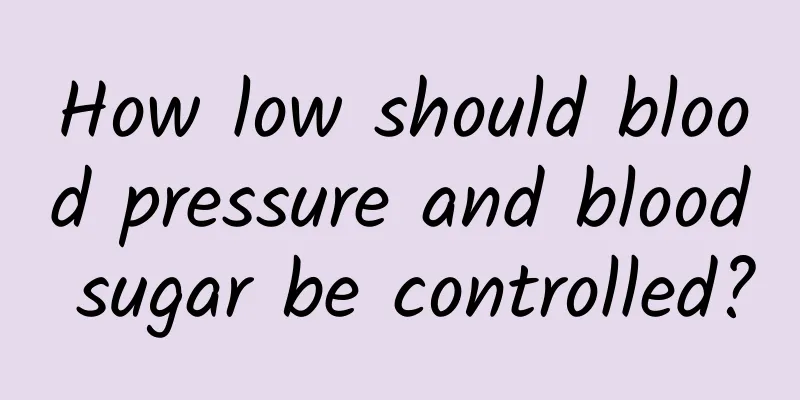How low should blood pressure and blood sugar be controlled?

|
Hypertension and diabetes are the two most common chronic diseases in my country, and their prevalence has been on the rise, but the disease control rate is still at a low level, with the control rate for hypertension patients being about 16.8%[1] and the control rate for diabetes patients being about 49.2%[2]. There are still quite a few patients who do not pay attention to their diseases or are not clear about the disease control goals. Currently, patients can measure their blood pressure and blood sugar daily at home to assess disease control without having to frequently go to the hospital to monitor disease changes. Therefore, in daily monitoring, it is necessary to know your blood pressure and blood sugar control targets, which is very helpful in controlling disease progression and the occurrence of complications. So do you know what your blood pressure and blood sugar should be controlled at?
Normally, the blood pressure control target for patients with hypertension is below 140/90 mmHg. However, blood pressure control for different populations should follow the principle of individualization. Considering safety and benefits, some patients can appropriately relax the target, but some patients need strict blood pressure control targets. (1) For patients with the following conditions, the blood pressure control target can be relaxed to below 150/90 mmHg: For the elderly aged 65 to 79, blood pressure should first be reduced to <150/90mmHg; if tolerated, it can be further reduced to <140/90mmHg. For the elderly aged ≥80, blood pressure should be reduced to <150/90mmHg. The treatment target for hypertension during pregnancy is below 150/100mmHg, but lowering blood pressure to below 130/80mmHg should be avoided to avoid affecting placental blood perfusion. (2) For patients with the following conditions, the blood pressure control target is below 140/90 mmHg: The blood pressure control target for patients with coronary heart disease is <140/90mmHg. As the blood pressure reduction target for hypertensive patients with coronary heart disease, it can be further reduced to <130/80mmHg if tolerated. It should be noted that diastolic blood pressure should not drop below 60mmHg. For elderly patients with severe coronary artery stenosis, blood pressure should not be too low. For hypertensive patients with chronic kidney disease, if albuminuria is less than 30 mg/d, the target of antihypertensive treatment is less than 140/90 mmHg. If albuminuria is greater than 30 mg/d, the blood pressure control target is more stringent accordingly. The blood pressure of patients with hypertension and lower limb arterial disease (lower limb arteriosclerosis, stenosis and occlusion) should be controlled at <140/90mmHg. (3) For patients with the following conditions, the blood pressure control target is more stringent and should be below 130/80 mmHg: For patients with hypertension and heart failure, the recommended blood pressure target is <130/80mmHg. For patients with hypertension and left ventricular hypertrophy but without heart failure, blood pressure can be lowered to <140/90mmHg first. If the patient can tolerate it well, it can be further lowered to <130/80mmHg, which is helpful to prevent heart failure. For hypertensive patients with chronic kidney disease, the blood pressure control target is <130/80 mmHg when albuminuria is 30-300 mg/d or higher. The blood pressure target can be appropriately relaxed for patients over 60 years old. The blood pressure target for hypertensive patients with diabetes is 130/80 mmHg. For the elderly or patients with severe coronary heart disease, a more relaxed blood pressure target of 140/90 mmHg should be adopted.
Blood sugar control target: Glycated hemoglobin (HbA1c) <7%; fasting blood sugar 4.4-7.0mmol/L; 2-hour postprandial blood sugar or non-fasting blood sugar <10.0mmol/L. Patients with type 2 diabetes who are younger, have a shorter course of disease, have a longer life expectancy, are free of complications, and have no cardiovascular disease can adopt a stricter HbA1C control target without hypoglycemia or other adverse reactions ( |
<<: How to sober up? How to use Fengdu tablets
>>: What is the difference between iodized and non-iodized salt? What kind of salt is good to buy?
Recommend
Cervical contact bleeding during gynecological examination
When reaching middle age, everyone's body wil...
How to treat primary amenorrhea?
When we suffer from a certain disease, the first ...
Second pregnancy scar uterine thickness dangerous
Most women choose cesarean section when giving bi...
Vulva itching with acne pictures
Vulvar itching and acne, but folliculitis in the ...
What is the cause of excessive vaginal discharge after menstruation?
Women's physical health is a relatively serio...
The back pain symptoms disappeared in a few days after the IUD was removed.
Important reminder: Many women will experience ba...
159 Can I eat vegetarian meals during my period?
Every month's menstrual period is very import...
Do you understand infertility?
Author: Dai Wei, deputy chief physician of Reprod...
Does severe uterine adhesion have any impact on pregnancy?
The uterus is the base camp for women's pregn...
Female urination process
For women, during the process of urination, many ...
Symptoms of allergic rhinitis? Here are three tips for you!
I ask you how much sorrow you can have, it's ...
Why do women have less water down there?
The female private parts also normally secrete a ...
The girl's lower abdomen suddenly hurts for a few seconds
If there is a sudden stabbing pain in the lower a...
What should we pay attention to when eating barbecue? Why is barbecue high in calories?
Barbecue is a food culture with a long history an...









